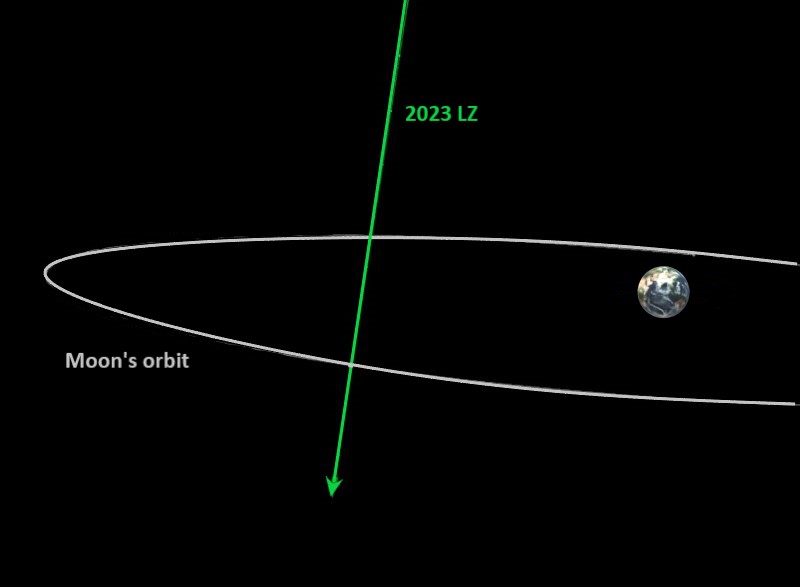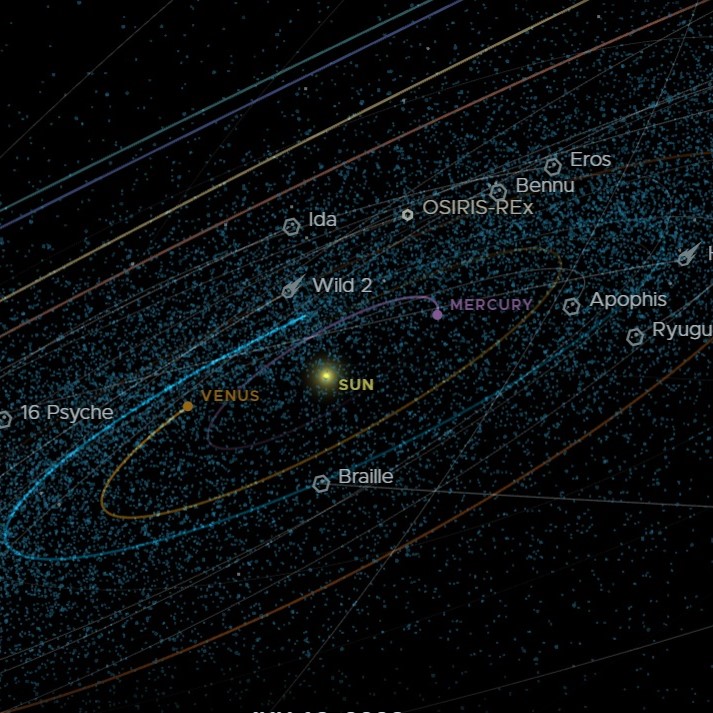Bus-sized asteroid to pass Earth
Hot on the heels of the house-sized asteroid that passed Earth on June 14, 2023, was a bus-sized asteroid that passed Earth on June 15, 2023. Astronomers discovered this new asteroid on Wednesday with the Mt. Lemmon Survey. The asteroid made its closest approach to Earth at 22:51 UTC (5:51 p.m. CDT) on Thursday. This asteroid is smaller but came closer, about 1/3 as far as the moon at closest approach. More specifically, it measured about 23 feet (7 m) and was about 68,700 miles (111,000 km) away. The new asteroid’s name is 2023 LM1.
For the 2nd time this week, a newly-discovered #asteroid will pass relatively close to Earth. Discovered before close approach, 2023 LM1 is 4-12 meters wide. It doesn't come as close to the geostationary satellites as the animation suggests, at it cruises well below their plane. pic.twitter.com/KtydrKMZz3
— Tony Dunn (@tony873004) June 15, 2023
Asteroid 2023 LZ passes Earth
At 18:36 UTC (1:36 p.m. CDT) on June 14, 2023, newly discovered asteroid 2023 LZ passed Earth inside the moon’s orbit. The asteroid spans about 33 to 105 feet (10 to 32 meters). Or, as NASA said on its website, it’s house-sized. The Pan-STARRS 2 observatory in Hawaii discovered asteroid 2023 LZ a few days ago, on June 10, 2023.
The space rock passed about 197,000 miles (317,000 km) from Earth’s surface. In comparison, the moon is about 239,000 miles (384,000 km) from Earth.
Despite its relatively large size and nearness, there was nothing to fear. Asteroid 2023 LZ was not a threat to Earth.

Tomorrow, newly-discovered asteroid 2023 LZ will pass 0.83 Lunar distances from Earth. It is 10-32 meters wide. pic.twitter.com/qDKNzclXjr
— Tony Dunn (@tony873004) June 13, 2023
How big, in order to strike Earth?
Our solar system formed from a vast cloud of gas and dust in space. Solid materials coalesced out of that cloud. And there’s still lots of leftover debris from the process that created the sun and planets, moving in the space of the solar system. These are the asteroids and comets.
NASA estimates that about 48.5 tons (44 metric tonnes) of meteorites hit Earth each day. Almost all the material is vaporized in Earth’s atmosphere, leaving bright trails fondly called “shooting stars.”
The Planetary Science Institute estimates that a space rock has to be at least 16 feet (5 meters) wide when it first meets Earth’s atmosphere in order to make it all the way to Earth’s surface.
Asteroid 2023 LZ spans about 33 to 105 feet (10 to 32 meters). So it is larger enough that – if it were to strike Earth’s surface – some fragments of it would likely reach to Earth’s surface. Now consider that Earth’s surface is mostly water. Most meteorites that do strike Earth fall into the ocean.
House-sized asteroids like 2023 LZ only very rarely strike us. Consider the approximately 59-foot-wide (18-meters-wide) space rock that entered Earth’s atmosphere at a shallow angle on February 15, 2013. The Chelyabinsk meteor broke windows in six Russian cities and sent some 1,500 people to seek medical aid, mostly for flying glass. It was briefly brighter than the sun as it fell through our skies, visible as far as 60 miles (100 km) away.
The Chelyabinsk meteor was the largest known natural object to have entered Earth’s atmosphere since the 1908 Tunguska event.
Another recent close approach
Asteroid 2023 LM1 and 2023 LZ come on the heels of another asteroid, 2023 LS, which snuck past Earth on June 9 at only a quarter of the distance to the moon. This asteroid, however, was quite a bit smaller, measuring about 6 to 20 feet (2 to 6 meters) across. 2023 LS’s discovery came after its closest approach. The reason scientists didn’t find it earlier was because they were blinded by the sun. The asteroid came from the direction of the bright sun, which is a weak spot in our defense against asteroids.
Fortunately, the European Space Agency (ESA) has a planned mission, called NEOMIR, which would be able to detect asteroids such as this that come at us from the direction of the sun. And Chelyabinsk was another asteroid that approached Earth from the direction of the sun.
Newly-discovered #asteroid 2023 LS snuck up on us. Thought to be 2-6 meters wide, it passed almost as close to Earth as our geostationary satellites. It came from the direction of the Sun, so it was not discoverable until after its close approach on June 9. pic.twitter.com/xeGH0FhiLG
— Tony Dunn (@tony873004) June 12, 2023

Bottom line: Wednesday’s house-sized asteroid was followed by a bus-sized asteroid that passed Earth Thursday. Neither one pose a threat to Earth.











